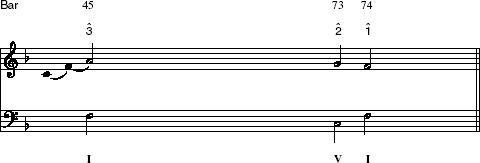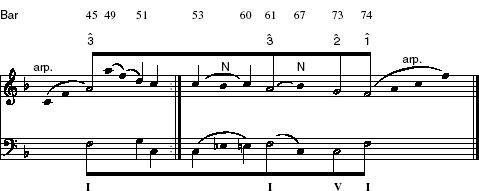1.2 Form in Beethoven's symphonic writing
Now let's look at an example from Beethoven's Eighth Symphony. We will start our analysis of the work with the shortest self-contained formal section, which is the trio from the Minuet and Trio that make up the third movement. The minuet occupies bars 1–44 of the movement, and the trio bars 45–78.
Activity 4
Listen twice to Beethoven's Eighth Symphony, third movement, bars 45–78. First, follow the music in the full score attached below. Then listen to it again whilst following the piano score (also attached below). Place a cross in the piano score underneath the first main tonic chord, and underneath the dominant and tonic chords that make up the final main cadence (remember that this movement is in F major). What similarities can you find between the opening and the close of the section?
Click to open the full score of Beethoven's Eighth Symphony, third movement [Tip: hold Ctrl and click a link to open it in a new tab. (Hide tip)] .
Click to open the piano score.
Answer
Discussion
You should have placed a cross underneath the F major chord in the first bar (bar 45), beneath the C major chord in bar 73, and the F major chord in bar 74 (which is prolonged to the end of the section). You probably noticed that the accompaniment in the lower strings is almost identical at the beginning and end of the section (and indeed this texture is maintained throughout), and you may have noted the three-note motive, C–D–E, which acts as an upbeat to bar 45 and to bars 72 and 74 (it is in the horn line; it is also found in bars 73 and 75, but turned upside down).
The task is to analyse how the music is structured between these opening and closing gestures, which look so similar on paper and yet have such different effects in performance. This analytical method is presented on video.
Activity 5
Watch the video clips below.
The first part of the video has built up a preliminary graph of the trio (Example 6). You should now add to this graph by printing it out using the link below the example, following the instructions below.
-
Identify two or three moments in the trio which you think are structurally important; in other words, moments which cannot be missed out of an analysis of the form of the section.
-
Indicate these moments by adding a note to the top line of the graph. Select the note which you think is most prominent, structurally, in the music at that point.
-
Add the note (or notes, if the harmony changes) in the bass which you think will indicate the harmonisation of these notes in the top line.
-
Identify these moments by putting the bar number over each note you have added.

Click to open graph (Example 6).
You may wish to listen through to the trio a couple of times before you do this activity.
Activity 6
When you have enlarged the graph in Example 6, watch the video below and follow my discussion of this activity.
The above video clips build up a complete background graph of the trio. This shows the fundamental structure, and some additional detail.
Example 7 gives the final graph of the trio.

